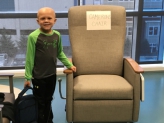Using Neurofibromatosis-1 (NF1) to understand Pediatric Brain Tumor Initiation

One out of five children with neurofibrosis-1 (NF1) develop a low-grade brain tumor (glioma), often in the optic pathway (optic glioma) that can lead to vision loss. Unfortunately, NF1 is currently incurable and how tumor-forming cells change from healthy to tumor states in these affected individuals is unclear. This gap in knowledge has hindered our ability to predict, prevent, or treat brain tumors in these patients.
Project Goal:
The goal of this proposal is to understand how tumor-forming cells undergo changes from healthy to tumor states in neurofibromatosis-1. This study will determine the tumor-intrinsic and extrinsic processes of cancer initiation in NF1-associated optic glioma. Our findings will help develop diagnostic and therapeutic strategies for these pediatric brain tumors.
Project Update 2024:
Whereas the tumor cell intrinsic oncogenic program is indispensable for cancer initiation, previous studies underscored the importance of tumor extrinsic factors during cancer initiation. Such dependencies are well illustrated by pediatric low-grade tumors; for example, the nervous system tumors developed in neurofibromatosis-1 (NF1), a cancer predisposition syndrome. One out of five children with NF1 will develop low-grade brain tumor (glioma), often in the optic pathway (optic glioma) that can lead to vision loss. Unfortunately, NF1 is currently incurable and how gliomas form and grow in this cancer predisposition syndrome is not fully understood. This gap in knowledge has hindered our ability to predict, prevent, or treat glioma in these patients. Due to a lack of human specimens, we leverage Nf1 mice that recapitulate the genetics of NF1 patients. These informative mouse models allow us to study tumor initiation and progression with a temporal-spatial resolution. Interestingly, NF1-associated glioma frequently develops in the optic pathway, suggesting a requirement of a permissive microenvironment for neoplastic transformation. We have recently demonstrated the critical role of neuronal activity and activity-dependent factors (Neuroligin-3) in driving the initiation and growth of Nf1 optic pathway glioma. Leveraging an Nf1 mouse model that recapitulates patients who develop optic glioma, we aim to further determine how Nf1 mutation affects the dynamics of glioma-initiating cells.

